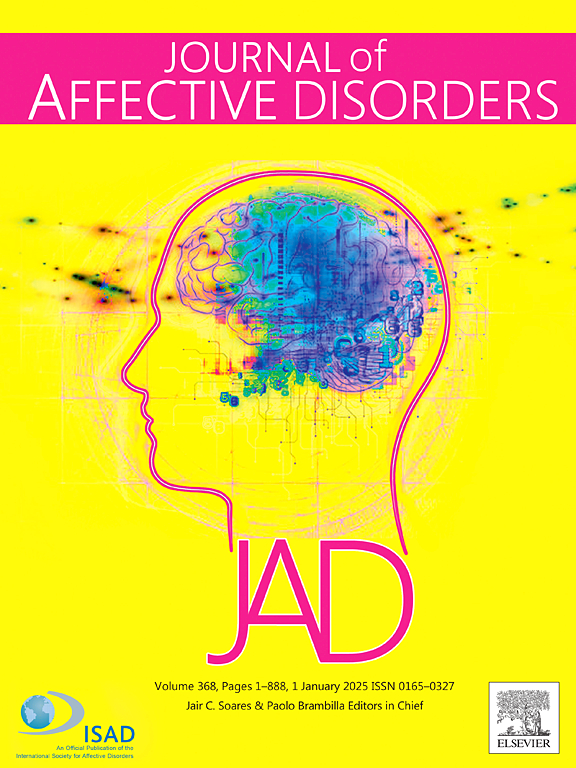慢性精神分裂症患者自杀意念的患病率及预测因素:抑郁、失眠和攻击的大规模研究
IF 4.9
2区 医学
Q1 CLINICAL NEUROLOGY
引用次数: 0
摘要
本研究旨在探讨慢性精神分裂症患者自杀意念(SI)的患病率及其预测因素,重点探讨抑郁、失眠和攻击的中介作用。方法对中国1271例慢性精神分裂症患者进行横断面研究。采用贝克自杀意念量表(SSI)、汉密尔顿抑郁评定量表(HAMD)、失眠严重程度指数(ISI)、改良显性攻击量表(MOAS)和阳性与阴性综合征量表(PANSS)对参与者进行评估。采用中介分析和系列中介分析来检验抑郁、失眠、攻击和自杀之间的关系。结果SI患病率为16.44%。抑郁对SI有直接和间接影响,其中失眠(间接影响= 0.255,95% CI[0.116, 0.426])和攻击性(间接影响= 0.115,95% CI[0.014, 0.260])是影响因素。序列中介分析显示抑郁→失眠→攻击→SI通路显著(β = 0.038, 95% CI[0.003, 0.094])。年龄较小、精神疾病家族史、饮酒、较高的PANSS评分、HAMD和MOAS评分升高是SI的显著预测因子。结论研究结果强调了慢性精神分裂症患者中SI的高患病率,并强调了抑郁、失眠和攻击在增加自杀风险中的复杂相互作用。针对这些中介因素的针对性干预,特别是失眠和攻击性,可能会减轻这一人群的SI。局限性:横断面设计排除了因果推论。样本主要是男性和单身,限制了普遍性。自我报告的测量方法可能会引入偏倚,而且药物效果也不受控制。本文章由计算机程序翻译,如有差异,请以英文原文为准。
Prevalence and predictors of suicidal ideation in patients with chronic schizophrenia: A large-scale study on the mediating roles of depression, insomnia and aggression
Background
This study aimed to investigate the prevalence and predictors of suicidal ideation (SI) in patients with chronic schizophrenia, focusing on the mediating roles of depression, insomnia, and aggression.
Methods
A cross-sectional study was conducted with 1271 patients diagnosed with chronic schizophrenia in China. Participants were assessed using the Beck Scale for Suicide Ideation (SSI), Hamilton Depression Rating Scale (HAMD), Insomnia Severity Index (ISI), Modified Overt Aggression Scale (MOAS), and Positive and Negative Syndrome Scale (PANSS). Mediation and serial mediation analyses were performed to examine the relationships among depression, insomnia, aggression, and SI.
Results
The prevalence of SI was 16.44 %. Depression exhibited both direct and indirect effects on SI, mediated by insomnia (indirect effect = 0.255, 95 % CI [0.116, 0.426]) and aggression (indirect effect = 0.115, 95 % CI [0.014, 0.260]). Serial mediation analysis revealed a significant pathway: depression → insomnia → aggression → SI (β = 0.038, 95 % CI [0.003, 0.094]). Younger age, family history of mental illness, alcohol consumption, higher PANSS scores, and elevated HAMD and MOAS scores were significant predictors of SI.
Conclusion
The findings highlight the high prevalence of SI in chronic schizophrenia and underscore the complex interplay of depression, insomnia, and aggression in increasing suicide risk. Targeted interventions addressing these mediators, particularly insomnia and aggression, may mitigate SI in this population.
Limitations
The cross-sectional design precludes causal inferences. The sample was predominantly male and single, limiting generalizability. Self-reported measures may introduce bias, and medication effects were not controlled.
求助全文
通过发布文献求助,成功后即可免费获取论文全文。
去求助
来源期刊

Journal of affective disorders
医学-精神病学
CiteScore
10.90
自引率
6.10%
发文量
1319
审稿时长
9.3 weeks
期刊介绍:
The Journal of Affective Disorders publishes papers concerned with affective disorders in the widest sense: depression, mania, mood spectrum, emotions and personality, anxiety and stress. It is interdisciplinary and aims to bring together different approaches for a diverse readership. Top quality papers will be accepted dealing with any aspect of affective disorders, including neuroimaging, cognitive neurosciences, genetics, molecular biology, experimental and clinical neurosciences, pharmacology, neuroimmunoendocrinology, intervention and treatment trials.
 求助内容:
求助内容: 应助结果提醒方式:
应助结果提醒方式:


